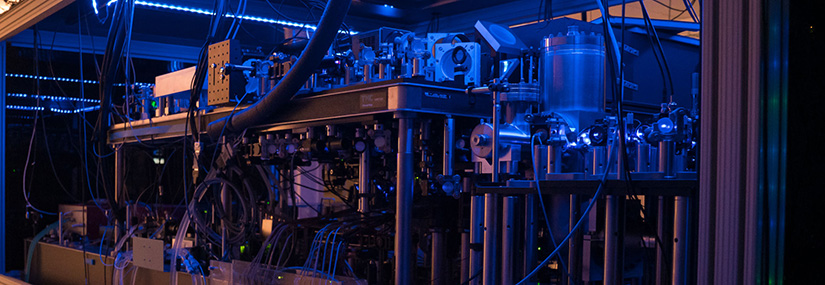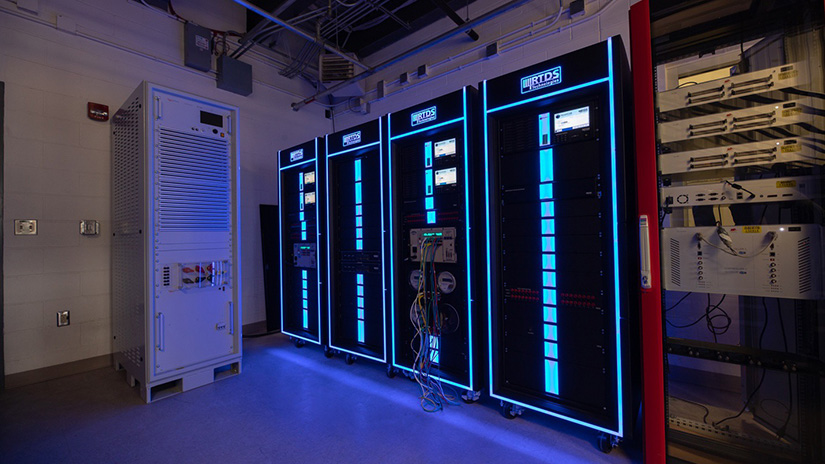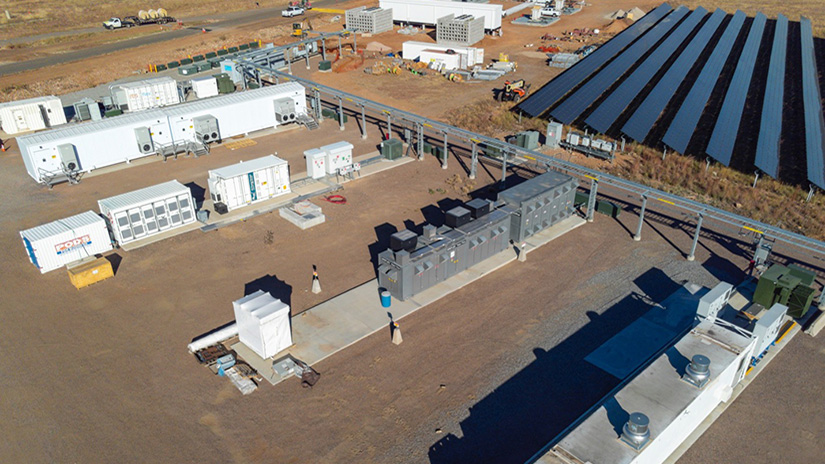NREL and Atom Computing Debut Open-Source Application for Quantum-in-the-Loop Studies

With its head-spinning size and connections, the power system is so complex that even supercomputers struggle to efficiently solve certain optimization problems. But quantum computers might fare better, and now researchers can explore that prospect thanks to a software interface between quantum computers and grid equipment.
The link from quantum to grid—achieved by a team from the National Renewable Energy Laboratory (NREL) with funding from the Department of Energy Office of Energy Efficiency and Renewable Energy, and in collaboration with RTDS Technologies Inc., and Atom Computing—allows researchers to perform “quantum-in-the-loop” experiments. And this capability goes beyond just energy devices: With NREL’s Advanced Research on Integrated Energy Systems (ARIES), researchers can run quantum in-the-loop within highly realistic power systems. Quantum in-the-loop could be an important next step for using quantum computing to optimize electric grid operations with the interconnection of increasingly complex distributed energy resources.
The research team successfully debuted their open-source interface near Boulder, Colorado, using a stack of RTDS real-time grid simulators and Atom Computing’s solution stack, which harnesses its atomic-array quantum computing technology. Their demonstration marked a historic moment for both quantum computing and power systems: For the first time, a quantum computing technology is integrated into a dynamic electric grid research platform, opening new horizons in grid and hardware validation.
“To assess the security of next-generation communication protocols and validate current and future quantum algorithms, it is critical to establish a real-world emulation environment with actual hardware and high-speed communication. This is precisely what we have developed at ARIES with quantum in-the-loop,” said Rob Hovsapian, an ARIES research advisor.
What Can Quantum Offer the Grid?
The research team’s quantum-in-the-loop framework is motivated by past findings that quantum algorithms are well suited for power system complexity, especially large optimization problems that overwhelm classical computers. Such complex problems are increasingly common as distributed energy resources proliferate and power flow becomes bidirectional.
“With the huge amount of ways energy can now be generated and supplied, it is very important to handle so many inputs and outputs, but classical computing-based optimizers are not designed to handle an exponential scale-up in input parameters that the industry is expected to witness in the next two decades,” said Sayonsom Chanda, a power system engineer at NREL. “We’re talking millions of inputs and outputs; that’s when classical computers start showing their limits, and quantum computers their benefits.”
When modeling the grid, every electric vehicle, home appliance, or sensor is a potential variable. Their data interact and coevolve in such convoluted ways that even a query into the grid’s available power becomes computationally difficult. The new interface simplifies the process of translating optimization problems into quantum variables and facilitates communication from quantum computers to power system simulations. As interest in quantum computing amplifies, the interface will help scientists classify the sorts of problems that can be solved by quantum computers and evaluate them in live experiments.
“Imagine, for example, that a city has to evacuate because of an incoming hurricane,” Hovsapian said. “All of a sudden you have to make decisions around efficient evacuation, which depend on the charge of electric vehicles, their path out of the city, the availability of charging stations, etc. Quantum computing may be the key to this kind of multiobjective optimization, and now we have the necessary tools to find out.”
Quantum physics—distinguished by concepts of probability and entanglement—offers a functionally different, and in some cases faster, form of computing. For example, the quantum Grover’s algorithm can theoretically solve search problems more efficiently than any known classical algorithm. With recent technical achievements by companies like Atom Computing, quantum algorithms are being tested on real applications, and power systems rank among the most enticing areas.
“Consider some of the most challenging problems in energy systems today: Making decisions based on large sensor networks; optimizing system recovery during fault conditions; securing communications between network devices. There are core applications that quantum computers may excel at, so we’re accelerating their adoption in power systems with this interface,” Hovsapian said.
Test Setup and Technology
NREL and other research facilities regularly validate new power technologies with hardware in-the-loop, but quantum in-the-loop has never existed until now. The demonstration relied on several exceptional capabilities: NREL’s provided nine digital real-time simulators, which communicated over the ESnet network to Atom Computing’s quantum emulator and eventually to Phoenix, its prototype system. Linking the two sites was the newly developed interface—a software for interpreting, converting, and transmitting data from each end in real time.

Digital real-time simulators can simulate power systems for research and planning. NREL and Atom Computing built an application programming interface between real-time simulators and quantum computers, allowing the simulations to communicate with quantum solvers for complex optimization problems. Photo by NREL
In an article written by the NREL team titled "Architecture for Quantum-in-the Loop Real-Time Simulations for Designing Resilient Smart Grids," Chanda and Hovsapian rigorously explain the interface’s design and provide an illustrative example: electric vehicle charging coordination.
“Researchers can use the quantum computer to develop and implement the quantum approximation optimization algorithm or the variational quantum eigensolver algorithms,” the article states. “These high-performance code snippets will help researchers to bridge the computational gaps between classical and quantum computers, and will be mostly based on familiar open-source frameworks such as QISKIT, QMuTPy, and Queso.”
Besides being tech-agnostic for quantum computing platforms, the interface is compatible with all real-time digital simulation platforms. Users can interact with the software through web browsers and a user-friendly interface to set desired optimization values, adjust quantum algorithms, and retrieve qubit measurements. The authors plan to publicly release the code on GitHub.
What Is Next?
Quantum computing is still very early-stage, and its value for power systems remains unproven, but that is precisely why this interface is so useful: All the theorizing and expectations around quantum computing can now be evaluated experimentally.
“It is critical for utilities to field test and adopt next generation technologies, and quantum computing is no exception,” Chanda said. “This interface is an enabler for future research into emerging grid problems.”

ARIES capabilities at NREL provide realistic power system environments for advanced research. The quantum-in-the-loop interface allows researchers to perform experiments on ARIES assets using quantum computers. Photo by NREL
Quantum in-the-loop is especially enabling with ARIES, where it joins other technologies in-the-loop, like commercial renewable energy resources, system controllers, supercomputer-powered emulations, sensors, and substation equipment. ARIES is as close to real as possible for power system experiments, and it continues to expand: By next year, ARIES will have the capacity to control 10,000 energy devices, among other investments. This capability offers unique and crucial realism for evaluating quantum algorithms and propelling advancements in power systems.
“The first optimization problem that we want to tackle is how best to draw power from different sources,” Chanda said. “You have some resources more closely located to certain loads and others that make more economic sense to deploy. Perhaps quantum computing can determine how to quickly switch power sources for resilience and efficiency.”
We are still at the dawn of quantum computing, but the U.S. Department of Energy and NREL have removed an important barrier to bringing this hopeful technology into the fold of energy systems.
Stay up to date by subscribing to the Energy Systems Integration newsletter.
"interface" - Google News
July 18, 2023 at 01:14AM
https://ift.tt/tOQ9yVg
Quantum Computers Can Now Interface With Power Grid Equipment - NREL
"interface" - Google News
https://ift.tt/HrdFkG6
https://ift.tt/lrGfi5V
Bagikan Berita Ini














0 Response to "Quantum Computers Can Now Interface With Power Grid Equipment - NREL"
Post a Comment